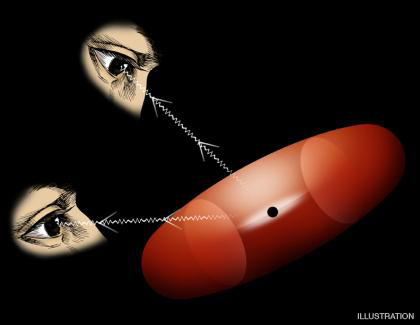A Quasar's Identity May Simply Be In The Eye Of The Beholder
This illustration demonstrates the possible different points-of-view from which astronomers observe quasars with X-ray satellites. If a quasar is oriented so that an observer's vantage point looks straight down the top of a quasar, then their view will not be obscured by the "donut" of gas and dust surrounding the core. This is the situation that astronomers believe occurs in "normal" quasars. However, 10 percent of quasars appear to absorb a great deal of their own radiation, including low-energy X-rays. Recent data from Chandra indicate that "shrouded" quasars appear this way because they are oriented so that astronomers are looking through the side of the obscuring ring of hot gas and dust. However, Chandra reveals that the underlying supermassive black holes behave like other quasars, and suggests that all quasars are the same types of object but just viewed from different angles.
This illustration shows two sets of eyes looking at an artist's concept of a quasar's black hole, which is represented by a dim red donut cut out to show a black dot in the middle with a wispy white disk around. This illustration demonstrates the possible different points-of-view from which astronomers observe quasars. If a quasar is oriented so that an observer's vantage point looks straight down the top of a quasar, then their view will not be obscured by the "donut" of gas and dust surrounding the core. This is the situation that astronomers believe occurs in "normal" quasars. However, 10 percent of quasars appear to absorb a great deal of their own radiation, including low-energy X-rays. Data from Chandra indicate that "shrouded" quasars appear this way because they are oriented so that astronomers are looking through the side of the obscuring ring of hot gas and dust. However, Chandra reveals that the underlying supermassive black holes behave like other quasars, and suggests that all quasars are the same types of object but just viewed from different angles.





